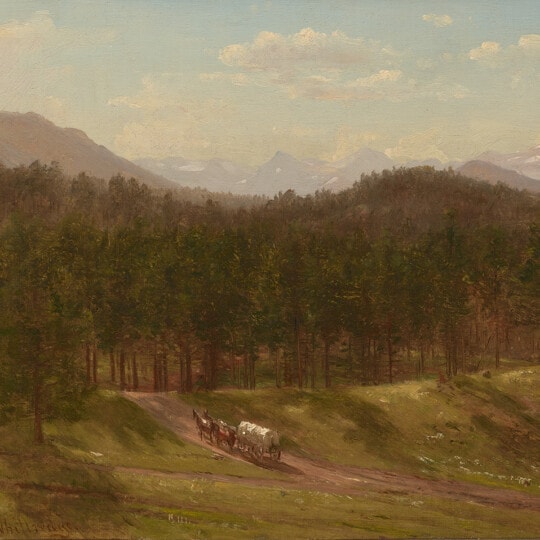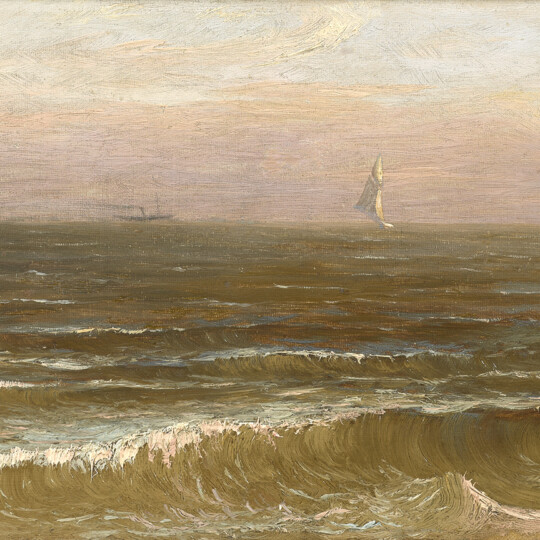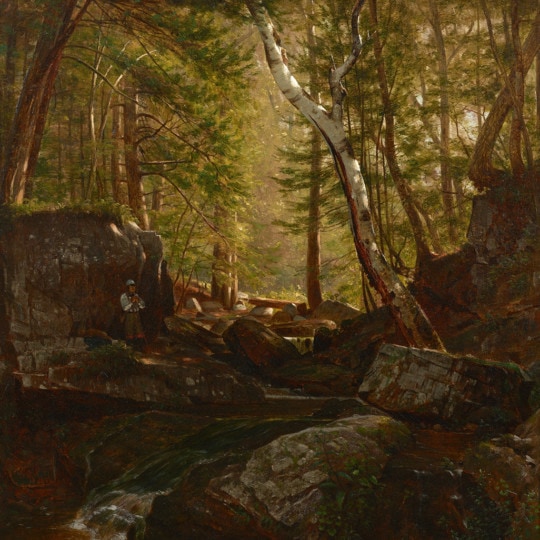Artist Biography
Landscape painter of the Hudson River School known for his forest interiors and mountain vistas
By Eve Perry
Whittredge’s Edenic forest scenes, painted in the Hudson River School style, reveal a highly personal quality that comes from the artist’s great affection for the land he depicts.
I. Biography
II. Chronology
III. Collections
IV. Exhibitions
V. Memberships
VI. Suggested
Landscape painter of the Hudson River School known for his forest interiors and mountain vistas
By Eve Perry
Whittredge’s Edenic forest scenes, painted in the Hudson River School style, reveal a highly personal quality that comes from the artist’s great affection for the land he depicts.
I. Biography
II. Chronology
III. Collections
IV. Exhibitions
V. Memberships
VI. Suggested Resources
VII. Biography
I. Biography
Born and raised in Springfield, Ohio, Thomas Worthington Whittredge moved to Cincinnati at the age of seventeen to apprentice as a sign and house painter. He then worked for brief periods at a daguerreotype studio in Indianapolis and as a portrait painter in Charleston, West Virginia before returning to Cincinnati in 1844 to pursue landscape painting.
Whittredge drew his influence from the Hudson River School painters, particularly Thomas Cole. He and painter William Lewis Sonntag borrowed from Cole’s style but added distinctive qualities of their own that led to the creation of a new regional style. Already an established landscape painter, Whittredge traveled to Europe in 1849 to further his artistic training. He lived for five years in Düsseldorf, Germany where he associated with artists of the Düsseldorf Academy. Among them was painter Emanuel Leutze who used Whittredge as a model for George Washington in his famous Washington Crossing the Delaware (1850; Metropolitan Museum of Art). In the summer of 1856, Whittredge made a sketching trip to Switzerland with fellow Hudson River School painter Albert Bierstadt. The two moved to Rome together the following year.
Whittredge returned to the United States in 1859 and applied the techniques he had developed in Europe to painting the American landscape. He set up a studio at the famous Tenth Street Studio in New York City and began spending his summers in Newport, Rhode Island. He experienced rapid success as a painter, and in 1862 was elected a full member the National Academy of Design. In 1866 he toured the Rocky Mountains for the first time as part of a government inspection project with painters John Frederick Kensett and Sanford Robinson Gifford. From the inspiration he gained on the trip, Whittredge produced large-scale, panoramic landscapes depicting the forests, mountains, and rivers of the American West.
In 1880 Whittredge moved to his final home in Summit, New Jersey. In 1893 he traveled to Mexico, along with painter Frederic Edwin Church, to sketch landscapes. Whittredge continued to progress as an artist into his eighties, incorporating new artistic developments in the New York art scene. He died in 1910 in Summit, New Jersey.
II. Chronology
1820 Born May 22 in Springfield, Ohio
1838 Painted portraits in Cincinnati
1840 Moved to Indianapolis and opened a daguerreotype studio
1841 Moved to Charleston, West Virginia; worked as a portrait painter
1844 Returned to Cincinnati to pursue landscape painting
1849 Traveled to Europe; lived in Düsseldorf, Germany
1857 Began living in Rome with Albert Bierstadt and Sanford Robinson Gifford
1859 Returned to the United States and set up studio at Tenth Street Studio building; began
spending summers in Newport, Rhode Island
1862 Elected full member of the National Academy of Design
1866 Visited the Rockies, as part of a government inspection tour, and New Mexico
1870 Visited the Rockies and New Mexico with John Frederick Kensett and Gifford
1971 Around this time traveled to Platte River region in Colorado with John Smillie
1880 Moved to Summit, New Jersey
1893 Traveled to Mexico with Frederic Edwin Church around this time
1887 Ortigies’ Art Gallery auctioned seventy-five oil paintings by Whittredge
1896 Traveled to Mexico with Church
1910 Died February 25 in Summit, New Jersey
III. Collections
Addison Gallery of American Art, MA
Amon Carter Museum, TX
Brooklyn Museum, NY
The Century Association, NY
Cincinnati Art Museum, OH
Cleveland Museum of Art, OH
Corcoran Gallery of Art, Washington D.C.
Denver Art Museum, CO
Joslyn Art Museum, NE
Metropolitan Museum of Art, NY
Museum of Fine Art, Boston, MA
National Museum of American Art, Washington D.C.
Newark Museum, NJ
Princeton University Art Museum, NJ
Shelburne Museum, VT
Smithsonian American Art Museum, Washington D.C.
Worcester Museum of Art, NY
IV. Exhibitions
1839 Cincinnati Art Academy
1841 Cincinnati Art Academy
1846 National Academy of Design
1847 American Art-Union
1853—67 Pennsylvania Academy of the Fine Arts
1860—1911 National Academy of Design
1861-87 Brooklyn Art Association
1876 Centennial Exposition, Philadelphia
1879 Pennsylvania Academy of Fine Art
1889 Paris Exposition
1901 Pan American Exposition, Buffalo, New York
1904 Pennsylvania Academy of the Fine Arts; St. Louis Exposition; Century Association
(solo)
1907—8 Corcoran Gallery
1944 Macbeth Gallery, New York (solo)
1969 Munson Williams Proctor Institute, Utica, NY (retrospective, traveled to Cincinnati
Art Museum and Albany Institute)
1970 Kennedy Gallery, New York City (solo)
1982 Morris Museum, Morristown, New Jersey (solo); Adams Davidson Gallery,
Washington D.C (solo)
V. Memberships
National Academy of Design
Artists Fund Society
Century Association
VI. Suggested Resources
Cibulka, Cheryl. Quiet Places, The American Landscapes of Worthington Whittredge. Washington D.C.:
Adams Davidson Gallery, 1982.
Dwight, E. H. Worthington Whittredge, exh. cat. Utica, N.Y.: Munson Williams Proctor Institution,
1969.
Falk, Peter Hastings, ed. Who Was Who in American Art, 1564—1975. Madison, Conn.: Sound View
Press, 1999.
Janson, Anthony F. Worthington Whittredge. Cambridge; New York: Cambridge University Press,
1989.
----------. “Worthington Whittredge: The Development of a Hudson River Painter, 1860—1868,”
The American Art Journal (April, 1979), 71–84.
----------. ‘Worthington Whittredge: Two Early Landscapes’, Detroit Institute of Arts Bulletin,
(Winger, 1977), pp. 199–208.
Omoto, Sadayishi. "Berkeley and Whittredge at Newport," Art Quarterly, vol. 27, no. 1 (Spring
1964), 43–56.
Whittredge, T. Worthington. The Autobiography of Worthington Whittredge. ed. John I. H. Baur.
Brooklyn: Brooklyn Museum of Art, 1942.
Landscape painter of the Hudson River School known for his forest interiors and mountain vistas
By Eve Perry
Whittredge’s Edenic forest scenes, painted in the Hudson River School style, reveal a highly personal quality that comes from the artist’s great affection for the land he depicts.
I. Biography
II. Chronology
III. Collections
IV. Exhibitions
V. Memberships
VI. Suggested Resources
VII. Biography
I. Biography
Born and raised in Springfield, Ohio, Thomas Worthington Whittredge moved to Cincinnati at the age of seventeen to apprentice as a sign and house painter. He then worked for brief periods at a daguerreotype studio in Indianapolis and as a portrait painter in Charleston, West Virginia before returning to Cincinnati in 1844 to pursue landscape painting.
Whittredge drew his influence from the Hudson River School painters, particularly Thomas Cole. He and painter William Lewis Sonntag borrowed from Cole’s style but added distinctive qualities of their own that led to the creation of a new regional style. Already an established landscape painter, Whittredge traveled to Europe in 1849 to further his artistic training. He lived for five years in Düsseldorf, Germany where he associated with artists of the Düsseldorf Academy. Among them was painter Emanuel Leutze who used Whittredge as a model for George Washington in his famous Washington Crossing the Delaware (1850; Metropolitan Museum of Art). In the summer of 1856, Whittredge made a sketching trip to Switzerland with fellow Hudson River School painter Albert Bierstadt. The two moved to Rome together the following year.
Whittredge returned to the United States in 1859 and applied the techniques he had developed in Europe to painting the American landscape. He set up a studio at the famous Tenth Street Studio in New York City and began spending his summers in Newport, Rhode Island. He experienced rapid success as a painter, and in 1862 was elected a full member the National Academy of Design. In 1866 he toured the Rocky Mountains for the first time as part of a government inspection project with painters John Frederick Kensett and Sanford Robinson Gifford. From the inspiration he gained on the trip, Whittredge produced large-scale, panoramic landscapes depicting the forests, mountains, and rivers of the American West.
In 1880 Whittredge moved to his final home in Summit, New Jersey. In 1893 he traveled to Mexico, along with painter Frederic Edwin Church, to sketch landscapes. Whittredge continued to progress as an artist into his eighties, incorporating new artistic developments in the New York art scene. He died in 1910 in Summit, New Jersey.
II. Chronology
1820 Born May 22 in Springfield, Ohio
1838 Painted portraits in Cincinnati
1840 Moved to Indianapolis and opened a daguerreotype studio
1841 Moved to Charleston, West Virginia; worked as a portrait painter
1844 Returned to Cincinnati to pursue landscape painting
1849 Traveled to Europe; lived in Düsseldorf, Germany
1857 Began living in Rome with Albert Bierstadt and Sanford Robinson Gifford
1859 Returned to the United States and set up studio at Tenth Street Studio building; began
spending summers in Newport, Rhode Island
1862 Elected full member of the National Academy of Design
1866 Visited the Rockies, as part of a government inspection tour, and New Mexico
1870 Visited the Rockies and New Mexico with John Frederick Kensett and Gifford
1971 Around this time traveled to Platte River region in Colorado with John Smillie
1880 Moved to Summit, New Jersey
1893 Traveled to Mexico with Frederic Edwin Church around this time
1887 Ortigies’ Art Gallery auctioned seventy-five oil paintings by Whittredge
1896 Traveled to Mexico with Church
1910 Died February 25 in Summit, New Jersey
III. Collections
Addison Gallery of American Art, MA
Amon Carter Museum, TX
Brooklyn Museum, NY
The Century Association, NY
Cincinnati Art Museum, OH
Cleveland Museum of Art, OH
Corcoran Gallery of Art, Washington D.C.
Denver Art Museum, CO
Joslyn Art Museum, NE
Metropolitan Museum of Art, NY
Museum of Fine Art, Boston, MA
National Museum of American Art, Washington D.C.
Newark Museum, NJ
Princeton University Art Museum, NJ
Shelburne Museum, VT
Smithsonian American Art Museum, Washington D.C.
Worcester Museum of Art, NY
IV. Exhibitions
1839 Cincinnati Art Academy
1841 Cincinnati Art Academy
1846 National Academy of Design
1847 American Art-Union
1853—67 Pennsylvania Academy of the Fine Arts
1860—1911 National Academy of Design
1861-87 Brooklyn Art Association
1876 Centennial Exposition, Philadelphia
1879 Pennsylvania Academy of Fine Art
1889 Paris Exposition
1901 Pan American Exposition, Buffalo, New York
1904 Pennsylvania Academy of the Fine Arts; St. Louis Exposition; Century Association
(solo)
1907—8 Corcoran Gallery
1944 Macbeth Gallery, New York (solo)
1969 Munson Williams Proctor Institute, Utica, NY (retrospective, traveled to Cincinnati
Art Museum and Albany Institute)
1970 Kennedy Gallery, New York City (solo)
1982 Morris Museum, Morristown, New Jersey (solo); Adams Davidson Gallery,
Washington D.C (solo)
V. Memberships
National Academy of Design
Artists Fund Society
Century Association
VI. Suggested Resources
Cibulka, Cheryl. Quiet Places, The American Landscapes of Worthington Whittredge. Washington D.C.:
Adams Davidson Gallery, 1982.
Dwight, E. H. Worthington Whittredge, exh. cat. Utica, N.Y.: Munson Williams Proctor Institution,
1969.
Falk, Peter Hastings, ed. Who Was Who in American Art, 1564—1975. Madison, Conn.: Sound View
Press, 1999.
Janson, Anthony F. Worthington Whittredge. Cambridge; New York: Cambridge University Press,
1989.
----------. “Worthington Whittredge: The Development of a Hudson River Painter, 1860—1868,”
The American Art Journal (April, 1979), 71–84.
----------. ‘Worthington Whittredge: Two Early Landscapes’, Detroit Institute of Arts Bulletin,
(Winger, 1977), pp. 199–208.
Omoto, Sadayishi. "Berkeley and Whittredge at Newport," Art Quarterly, vol. 27, no. 1 (Spring
1964), 43–56.
Whittredge, T. Worthington. The Autobiography of Worthington Whittredge. ed. John I. H. Baur.
Brooklyn: Brooklyn Museum of Art, 1942.



